The Forestry Commission is a non-ministerial government department responsible for the management of publicly owned forests and the regulation of both public and private forestry in England.
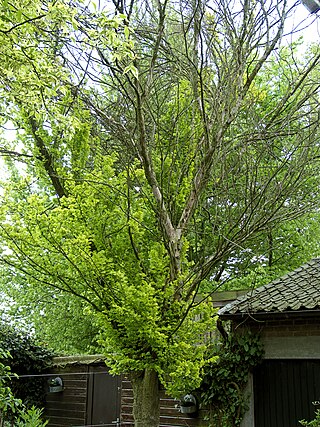
Dutch elm disease (DED) is caused by a member of the sac fungi (Ascomycota) affecting elm trees, and is spread by elm bark beetles. Believed to be originally native to Asia, the disease was accidentally introduced into America, Europe, and New Zealand. In these regions it has devastated native populations of elms that did not have resistance to the disease. The name "Dutch elm disease" refers to its identification in 1921 and later in the Netherlands by Dutch phytopathologists Bea Schwarz and Christine Buisman, who both worked with professor Johanna Westerdijk. The disease affects species in the genera Ulmus and Zelkova, therefore it is not specific to the Dutch elm hybrid.

Ulmus glabraHudson, the wych elm or Scots elm, has the widest range of the European elm species, from Ireland eastwards to the Ural Mountains, and from the Arctic Circle south to the mountains of the Peloponnese and Sicily, where the species reaches its southern limit in Europe; it is also found in Iran. A large deciduous tree, it is essentially a montane species, growing at elevations up to 1,500 m (4,900 ft), preferring sites with moist soils and high humidity. The tree can form pure forests in Scandinavia and occurs as far north as latitude 67°N at Beiarn in Norway. It has been successfully introduced as far north as Tromsø and Alta in northern Norway (70°N). It has also been successfully introduced to Narsarsuaq, near the southern tip of Greenland (61°N).
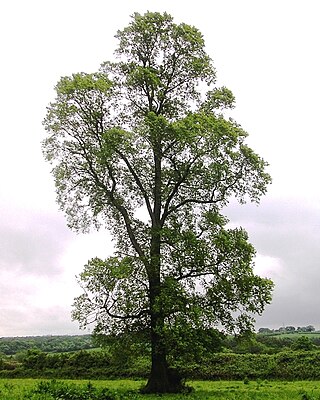
Ulmus minor subsp. minor, the narrow-leaved elm, was the name used by R. H. Richens (1983) for English field elms that were not English elm, Cornish elm, Lock elm or Guernsey elm. Many publications, however, continue to use plain Ulmus minor for Richens's subspecies, a name Richens reserved for the undifferentiated continental field elms. Dr Max Coleman of Royal Botanic Garden Edinburgh argued in his 2002 paper 'British Elms' that there was no clear distinction between species and subspecies.

Drumnadrochit is a village in the Highland local government council area of Scotland, lying near the west shore of Loch Ness at the foot of Glen Urquhart. The village is close to several neighbouring settlements: the villages of Milton to the west, Kilmore to the east and Lewiston to the south. The villages act as a centre for regional tourism beside Loch Ness, as well as being a local economic hub for the nearby communities.

The Caledonian Forest is the ancient (old-growth) temperate forest of Scotland. The forest today is a reduced-extent version of the pre-human-settlement forest, existing in several dozen remnant areas.

Trees for Life is a registered charity working to rewild the Scottish Highlands.

Dudley Coutts Marjoribanks, 1st Baron Tweedmouth, also known as the Laird of Guisachan and Glenaffric, was a Scottish businessman and a Liberal politician who sat in the House of Commons from 1853 until 1880, when he was elevated to the peerage as Baron Tweedmouth. He was the breeder of the first golden retriever.

Glen Affric is a glen south-west of the village of Cannich in the Highland region of Scotland, some 15 miles west of Loch Ness. The River Affric runs along its length, passing through Loch Affric and Loch Beinn a' Mheadhoin. A minor public road reaches as far as the end of Loch Beinn a' Mheadhoin, but beyond that point only rough tracks and footpaths continue along the glen.
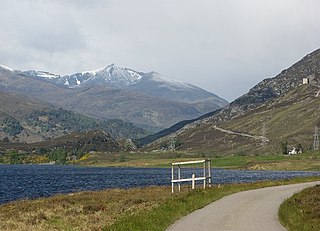
Glen Strathfarrar is a glen in the Highland region of Scotland, near Loch Ness.

Borgie is a hamlet in Sutherland, Highland, Scotland. Historically it was part of the 12,600-acre (5,100-hectare) Tongue estate with shooting rights, and it contains the Borgie Lodge, now a bed and breakfast. Borgie is noted for its salmon, which are caught in the nearby River Borgie.
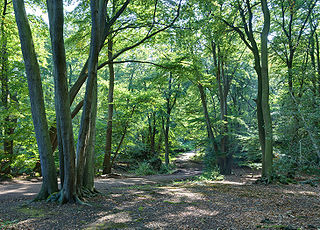
The United Kingdom, being in the British Isles, is ideal for tree growth, thanks to its mild winters, plentiful rainfall, fertile soil and hill-sheltered topography. In the absence of people, much of Great Britain would be covered with mature oaks as well as savannah-type of plains, except for Scotland. Although conditions for forestry are good, trees face threats from fungi, parasites and pests. Nowadays, about 13% of Britain's land surface is wooded. European countries average 39%, but this varies widely from 1% (Malta) to 66% (Finland). As of 2021, government plans call for 30,000 hectares to be reforested each year. Efforts to reach these targets have attracted criticism for planting non-native trees, or trees that are out of place for their surroundings, leading to ecological changes.

Scotland is ideal for tree growth, thanks to its mild winters, plentiful rainfall, fertile soil and hill-sheltered topography. As of 2019 about 18.5% of the country was wooded. Although this figure is well below the European Union (EU) average of 43%, it represents a significant increase compared to the figure of 100 years previously: in 1919 it was estimated that only 5% of the country's total land area was covered in forest. The Scottish Government's Draft Climate Change Plan has set an aim of increasing coverage to 21% of Scotland by 2032, with the rate of afforestation rising to 15,000 hectares per year by 2024.
British wildwood, or simply the wildwood, is the natural forested landscape that developed across much of Prehistoric Britain after the last ice age. It existed for several millennia as the main climax vegetation in Britain given the relatively warm and moist post-glacial climate and had not yet been destroyed or modified by human intervention. From the start of the Neolithic period, the wildwood gradually gave way to open plains and fields as human populations grew and people began to significantly shape and exploit the land to their advantage. The wildwood concept has been popularised in particular by ecologist and countryside historian Oliver Rackham in his various works

Mullach Fraoch-choire is a 1,102-metre (3,615 ft) mountain – a Munro – in the Northwest Highlands of Scotland on a ridge extending north for 8 kilometres (5.0 mi) between Loch Cluanie in Glenmoriston and upper Glen Affric. It is within the Glen Affric National Scenic Area and Glen Affric National Nature Reserve.

Argyll Forest Park is a forest park located on the Cowal Peninsula in Argyll and Bute, Scottish Highlands. Established in 1935, it was the first forest park to be created in the United Kingdom. The park is managed by Forestry and Land Scotland, and covers 211 km2 in total.

Glen Nant is a glen lying to the south of Taynuilt in the Argyll and Bute council area of Scotland. An area of woodland of 339 hectares on the western side of the River Nant is designated as national nature reserve (NNR), which is owned and managed by Forestry and Land Scotland (FLS). It is an example of an Atlantic Oakwood, and is one of largest areas of upland oak woodland in north Argyll.
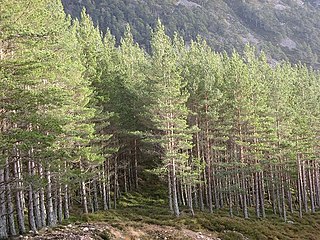
Invereshie and Inshriach is a national nature reserve on the western flank of the Cairngorms in the Highland council area of Scotland. The reserve covers habitats at a range of different altitudes, ranging from Caledonian Forest beside the River Feshie in the west, via bog and open moorland, to an arctic-alpine environment on the Cairngorm plateau. The Munro summit of Sgòr Gaoith (1118 m) lies on the eastern boundary of the reserve. The forested areas of the reserve form part of an expanse of Caledonian pinewood that stretches from Glen Feshie to Abernethy, and which as a whole forms the largest single area of this habitat remaining in Scotland. The reserve is owned and managed jointly by NatureScot and Forestry and Land Scotland (FLS): NatureScot own the Invereshie portion of the reserve and FLS the Inshriach area.

Loch Beinn a' Mheadhoin is a freshwater loch in Inverness-shire, Scotland. It is one of several lochs in Glen Affric, a National Nature Reserve within Scotland's Caledonian Forest.



















